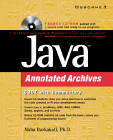Documented Code for Fifty Three Simple Programs
Well explained code, plenty of examples, covers apps, servlets, and beans, programs are not very challenging.
ORIGINAL DRAFT
Almost any programmer can tell you how much they’ve learned from looking at other people’s code. The code may be from a program they’ve had to maintain, an article or book, or the result of code reviews, among other sources. You learn a lot from other people’s code because a well written program demonstrates techniques and style that helps you build better software. This book takes that basic idea to an obvious conclusion. Well annotated code can teach programmers in practical ways and a book that focusses on explaining the in-depth functionally of small programs has plenty of value. Unfortunately, the usefulness off the book depends on how useful you find the examples, so its hard to make a general statement about this book’s inherent value.
Java Annotated Archives explains the code for 53 small programs, in the form of applets, servlets, components and applications. Few of these are complicated, however, so they may be considered toy programs by some readers. The book is divided into four parts, covering Applets, JavaBeans, Applications and Servlets. The Applets are divided into 6 chapters with topics like web page enhancements, business and finance, networking and communications, multimedia, games, tools and utilities. Part II covers visible and invisible JavaBeans.
Part III covers applications, including GUI, command line, client/server and database applications. The servlet chapters are sketchy and include the basics along with a look at multi-tiered architectures. Applets like animated banners, image buttons, LED tickers , and calculators fit into the whiz-bang category, teach a little but basically add up to code you can find anywhere on the web. Some of the mail and FTP code is more useful, as might be the MPEG player which seems ambitious at first glance. The games are simple and fun, but the tools are overly simplistic. The JavaBeans chapters are not very comprehensive but remain useful in considering what it means to package a JavaBean. The servlets are overly simple, with a visit counter, page wrapper and feedback servlet. not material that would satisfy an enterprise developer.
If you like to learn from reading source code and see the value in carefully walking through the code, you’ll love this book. There’s room for a book like this that looks at more complex applications but there’s something for everyone somewhere in this book. Whether you think the price tag is in the ballpark entirely depends on how many of the concepts being explored are likely to help you understand something useful. I’d encourage you to take a look at this book. Flip through the pages and make your decision based on the example code. The writing is good and the explanations insightful, but the decision has to be based on how interested you are in the 53 examples.
